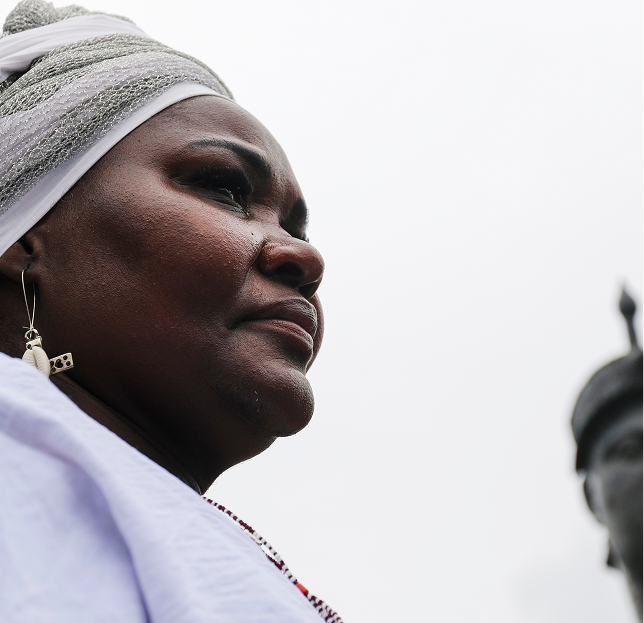Health promotion for the black population and pathways to racial equity in Brazil
Public health reflects the social reality of a country. Good health is the result of a set of factors, such as education, income, and access to healthy food, housing and sanitation.
In Brazil, where 56% of the population self-declares as black or brown, structural racism prevents these groups from having full access to these fundamental rights. This negatively affects disease prevention and health promotion for this majority group in the population and compromises the quality of life of millions of Brazilians.
Population distribution by color/race in Brazil
(Census 2022)
Brown: 45,3%
White: 43,5%
Black:10,2%
Indigenous: 0,8%
Yellow: 0,4 %
This information is collected by the Brazilian Institute of Geography and Statistics (IBGE), which uses the criterion of self-declaration to classify the Brazilian population into five racial categories: yellow, white, indigenous, brown and black. In Brazil, the black population is made up of the sum of the black and brown groups, representing the majority of Brazilians (55.5%).
70%
of people in the poverty and extreme poverty range are black.
60%
of households headed by Black people live with food insecurity.
2X
is the average wage gap between Black and white people, with black people earning less.
Source: IBGE, Síntese de Indicadores Sociais, 2023
65%
higher is the illiteracy rate among Black people compared to white people.
These barriers to access are reflected in worse health indicators for black people.
Maternal mortality is 65% higher among black women
Black people died 57% more than white people in the first year of the COVID-19 pandemic
74,7% of hospitalizations for sickle cell disease were black people
In 2019, 62,9% of black people considered their health good or very good, while among white people this percentage was 71%
The last 30 years have brought significant advances in reducing racial inequity in health, driven by the struggle of black movements, such as the creation of the National Comprehensive Health Policy for the Black Population in 2009, the result of the coordinated action between social movements, experts and the state. Still, challenges persist, and the search for equity must be ongoing.
To deepen the understanding of inequalities, data must be properly collected, and evidence produced. Although there are databases with good coverage in terms of race/color in Brazil, many systems still do not have this.
There is another challenge: It is not enough to have the data. The racial dimension needs to be truly considered in decision-making in a multisectoral and transversal way. And this cannot be done sporadically: Constant monitoring of the health statistics of black people is necessary.
With this in mind, the Ministry of Racial Equity (MIR) has partnered with the public health organization Vital Strategies to create this dashboard, which provides timely and accessible information for the whole of society, especially for public administration. With funding from Instituto Ibirapitanga, this project articulates different partners to generate, interpret and disseminate data, gradually promoting the transformation of existing racial inequities in health policies in Brazil.
The Racial Equity and Health portal consists of a dynamic dashboard, which will be updated periodically with new research as it is developed by partner entities and researchers in the areas of epidemiology and racial inequities in health.
In addition to gathering new studies, with information aimed at informing decision-making, this dashboard is committed to action, bringing proposals and recommendations aimed at strengthening policies for racial equity in health.
Health promotion for the black population and pathways to racial equity in Brazil
Public health reflects the social reality of a country. Good health is the result of a set of factors, such as education, income, and access to healthy food, housing and sanitation.
In Brazil, where 56% of the population self-declares as black or brown, structural racism prevents these groups from having full access to these fundamental rights. This negatively affects disease prevention and health promotion for this majority group in the population and compromises the quality of life of millions of Brazilians.
Population distribution by color/race in Brazil
(Census 2022)
Brown: 45,3%
White:43,5%
Black:10,2%
Indigenous: 0,8%
Yellow:0,4 %
This information is collected by the Brazilian Institute of Geography and Statistics (IBGE), which uses the criterion of self-declaration to classify the Brazilian population into five racial categories: yellow, white, indigenous, brown and black. In Brazil, the black population is made up of the sum of the black and brown groups, representing the majority of Brazilians (55.5%).
70%
of people in the poverty and extreme poverty range are black.
60%
of households headed by black people live with food insecurity.
Source: PENSSAN, 2022
2X
is the average wage gap between black and white people, with black people earning less.
Source: IBGE, Síntese de Indicadores Sociais, 2023
65%
higher is the illiteracy rate among blacks compared to whites.
These barriers to access are reflected in worse health indicators for black people.
Maternal mortality is 65% higher among black women
Black people die 57% more than white people in the first year of the COVID-19 pandemic
74,7% of hospitalizations for sickle cell disease were black people
In 2019, 62,9% of black people considered their health good or very good, while among white people this percentage was 71%
The last 30 years have brought significant advances in reducing racial inequity in health, driven by the struggle of black movements, such as the creation of the National Comprehensive Health Policy for the Black Population in 2009, the result of the coordinated action between social movements, experts and the state. Still, challenges persist, and the search for equity must be ongoing.


To deepen the understanding of inequalities, data must be properly collected, and evidence produced. Although there are databases with good coverage in terms of race/color in Brazil, many systems still do not have this.
There is another challenge: It is not enough to have the data. The racial dimension needs to be truly considered in decision-making in a multisectoral and transversal way. And this cannot be done sporadically: Constant monitoring of the health statistics of black people is necessary.
With this in mind, the Ministry of Racial Equity (MIR) has partnered with the public health organization Vital Strategies to create this dashboard, which provides timely and accessible information for the whole of society, especially for public administration. With funding from Instituto Ibirapitanga, this project articulates different partners to generate, interpret and disseminate data, gradually promoting the transformation of existing racial inequities in health policies in Brazil.
The Racial Equity and Health portal consists of a dynamic dashboard, which will be updated periodically with new research as it is developed by partner entities and researchers in the areas of epidemiology and racial inequities in health.
In addition to gathering new studies, with information aimed at informing decision-making, this dashboard is committed to action, bringing proposals and recommendations aimed at strengthening policies for racial equity in health.
Latest studies

The everyday experience of discrimination is one of the mechanisms through which racism operates and produces inequities in health. Recognizing this reality, the Everyday Discrimination Scale, originally proposed by Professor David Williams of Harvard University, was applied for the first time nationally in Brazil. The ...



